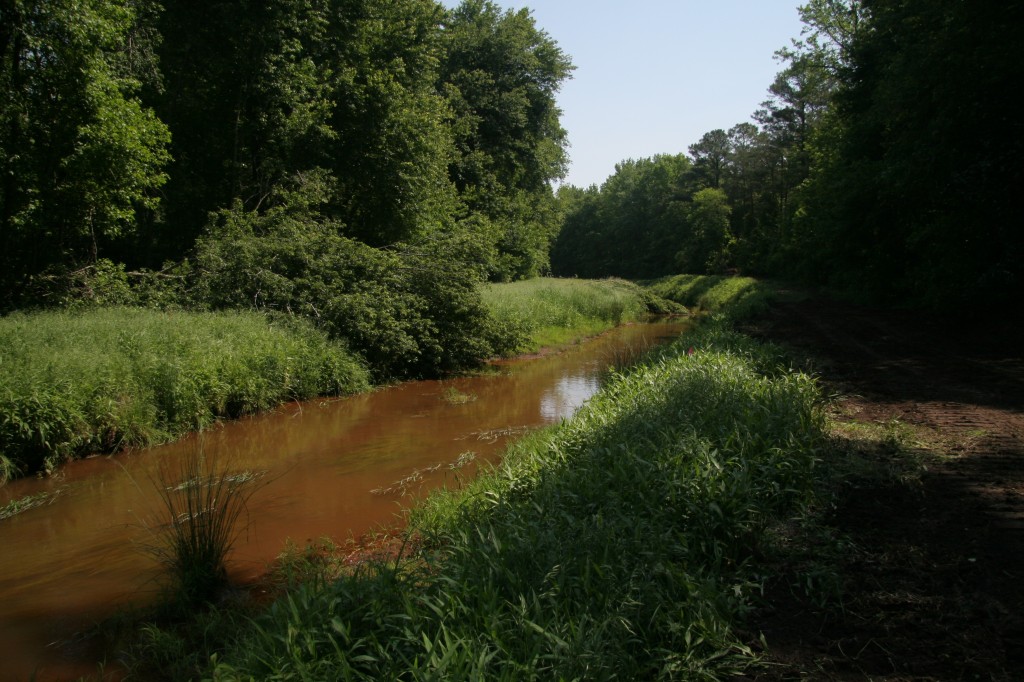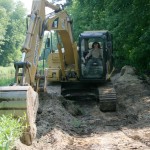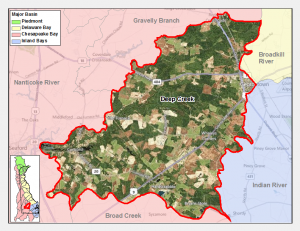Redden State Forest project is part of Chesapeake Bay restoration effort
Department of Agriculture | Division of Watershed Stewardship | Forest Service | Date Posted: Friday, June 7, 2013
Department of Agriculture | Division of Watershed Stewardship | Forest Service | Date Posted: Friday, June 7, 2013

The long-term battle to restore the Chesapeake Bay is quietly being waged right here – on the Deep Creek Tract of Redden State Forest in Georgetown, near the intersection of Rum Bridge Road and Rt. 404/18. That’s where Guy Cooper and Mike Green of the Delaware Forest Service are using heavy equipment to carefully move soft, sandy soil along the placid, sun-dappled waters of the nearby tax ditch. The methodical work is part of a proven strategy to lower the bank level in 17 key locations as a way to “reconnect” the artificial waterway to its natural floodplain. The new configuration will allow water from excessive rainfall events to overspill the banks and flow into nearby woodlands, letting the forest serve as a natural filter by absorbing excess sediment, nutrients, and pollutants.

The project is one thread in the wider fabric of the Nanticoke Watershed Restoration Plan – a cooperative strategy to improve the health of the Nanticoke Watershed, a key contributor to water quality in the Chesapeake Bay. The effort has involved local tax ditch officials, nonprofit groups such as the Nanticoke Watershed Alliance, state agencies such as Delaware’s Dept. of Natural Resources and Environmental Protection (DNREC) and the Delaware Forest Service, and federal partners such as the U.S. Environmental Protection Agency (EPA), the USDA Natural Resources Conservation Service (NRCS), and the U.S. Fish and Wildlife Service.

Deep Creek covers 63 square miles and comprises one of 15 sub-watersheds that constitute the Chesapeake Bay Basin. These areas contain headwater forests for the Nanticoke River that also serve as important wildlife habitats for an abundance of unique plants and animals. The cost – about $1,000 per cut-out depending on the amount of soil and material to be moved – is funded by a five-year grant from the EPA administered by DNREC that targets non-point source pollution.
The plan to reconnect channelized waterways to forested floodplains has been implemented successfully in the region before: U.S. Fish and Wildlife officials restored 600 acres along the Pocomoke River in nearby Maryland, and last year a project was completed in Redden State Forest in the nearby Gravelly Branch sub-watershed.
For private landowners, federal agencies like the NRCS offer financial and technical assistance programs such as its Wetlands Reserve Program (WRP) to incentivize private landowners to implement water quality projects such as planting trees along riparian areas. However, public lands such as those at Redden State Forest also offer unique opportunities for water quality restoration, according to Brian Jennings, Fish and Wildlife Biologist at the U.S. Fish & Wildlife Service’s Chesapeake Bay Field Office.
“Research shows that every one acre of flood plain can treat excess run off from four acres of agricultural fields” Jennings said. “In this project, we’re restoring 50 acres of floodplain, which works out to about 200 acres.”
According to Jennings, the natural hydrologic features of the connection points are designed to be triggered when the tax ditch channel achieves what is known as “bankfull discharge,” which would likely occur during a 1- to 2-year rainfall event – equivalent to approximately three inches of precipitation at a single time. Without the new cut-outs, a major storm would cause the ditch to act as a rapid conduit for excessive runoff from nearby fields and impervious surfaces: fast-tracking sediments, pollutants, and excessive nutrients downstream into the bay.
When the region is experiencing periods of lower precipitation, the advantages of the changes may not be always readily apparent, but they have proven worthwhile over the long haul.
According to Erich Burkentine, the Delaware Forest Service’s regional forester in Sussex County, the effort is showing signs of success: “It’s definitely working the way it is supposed to. Now that we’ve had a bit more rainfall this year than recent years, we can see how the water has been diverted into the woodlands in places where the reconnects have been installed.”
Though the project is just a small part of the overall Chesapeake Bay Watershed restoration, Jennings is quick to acknowledge one of the program’s key partners – managers of the local tax ditch associations – who must give approval to install the new structures after receiving assurances that the newly-reconfigured banks will not destabilize existing tax ditch right-of-ways.
In addition to improved water quality, reconnecting the channels can help reduce flooding downstream and also provide habitat for key species that thrive in forest wetland ecosystems.
“We’re trying to restore the natural function of the forests in the flood plain. Not only do we want good water quality, but that will also translate into quality wildlife habitat,” Jennings said.
More information:
Brian Jennings, U.S. Fish and Wildlife Biologist, U.S. Fish and Wildlife Service
302-684-4423 (office)
703-501-0593 (cell)
Keep up to date by receiving a daily digest email, around noon, of current news release posts from state agencies on news.delaware.gov.
Here you can subscribe to future news updates.
Department of Agriculture | Division of Watershed Stewardship | Forest Service | Date Posted: Friday, June 7, 2013

The long-term battle to restore the Chesapeake Bay is quietly being waged right here – on the Deep Creek Tract of Redden State Forest in Georgetown, near the intersection of Rum Bridge Road and Rt. 404/18. That’s where Guy Cooper and Mike Green of the Delaware Forest Service are using heavy equipment to carefully move soft, sandy soil along the placid, sun-dappled waters of the nearby tax ditch. The methodical work is part of a proven strategy to lower the bank level in 17 key locations as a way to “reconnect” the artificial waterway to its natural floodplain. The new configuration will allow water from excessive rainfall events to overspill the banks and flow into nearby woodlands, letting the forest serve as a natural filter by absorbing excess sediment, nutrients, and pollutants.

The project is one thread in the wider fabric of the Nanticoke Watershed Restoration Plan – a cooperative strategy to improve the health of the Nanticoke Watershed, a key contributor to water quality in the Chesapeake Bay. The effort has involved local tax ditch officials, nonprofit groups such as the Nanticoke Watershed Alliance, state agencies such as Delaware’s Dept. of Natural Resources and Environmental Protection (DNREC) and the Delaware Forest Service, and federal partners such as the U.S. Environmental Protection Agency (EPA), the USDA Natural Resources Conservation Service (NRCS), and the U.S. Fish and Wildlife Service.

Deep Creek covers 63 square miles and comprises one of 15 sub-watersheds that constitute the Chesapeake Bay Basin. These areas contain headwater forests for the Nanticoke River that also serve as important wildlife habitats for an abundance of unique plants and animals. The cost – about $1,000 per cut-out depending on the amount of soil and material to be moved – is funded by a five-year grant from the EPA administered by DNREC that targets non-point source pollution.
The plan to reconnect channelized waterways to forested floodplains has been implemented successfully in the region before: U.S. Fish and Wildlife officials restored 600 acres along the Pocomoke River in nearby Maryland, and last year a project was completed in Redden State Forest in the nearby Gravelly Branch sub-watershed.
For private landowners, federal agencies like the NRCS offer financial and technical assistance programs such as its Wetlands Reserve Program (WRP) to incentivize private landowners to implement water quality projects such as planting trees along riparian areas. However, public lands such as those at Redden State Forest also offer unique opportunities for water quality restoration, according to Brian Jennings, Fish and Wildlife Biologist at the U.S. Fish & Wildlife Service’s Chesapeake Bay Field Office.
“Research shows that every one acre of flood plain can treat excess run off from four acres of agricultural fields” Jennings said. “In this project, we’re restoring 50 acres of floodplain, which works out to about 200 acres.”
According to Jennings, the natural hydrologic features of the connection points are designed to be triggered when the tax ditch channel achieves what is known as “bankfull discharge,” which would likely occur during a 1- to 2-year rainfall event – equivalent to approximately three inches of precipitation at a single time. Without the new cut-outs, a major storm would cause the ditch to act as a rapid conduit for excessive runoff from nearby fields and impervious surfaces: fast-tracking sediments, pollutants, and excessive nutrients downstream into the bay.
When the region is experiencing periods of lower precipitation, the advantages of the changes may not be always readily apparent, but they have proven worthwhile over the long haul.
According to Erich Burkentine, the Delaware Forest Service’s regional forester in Sussex County, the effort is showing signs of success: “It’s definitely working the way it is supposed to. Now that we’ve had a bit more rainfall this year than recent years, we can see how the water has been diverted into the woodlands in places where the reconnects have been installed.”
Though the project is just a small part of the overall Chesapeake Bay Watershed restoration, Jennings is quick to acknowledge one of the program’s key partners – managers of the local tax ditch associations – who must give approval to install the new structures after receiving assurances that the newly-reconfigured banks will not destabilize existing tax ditch right-of-ways.
In addition to improved water quality, reconnecting the channels can help reduce flooding downstream and also provide habitat for key species that thrive in forest wetland ecosystems.
“We’re trying to restore the natural function of the forests in the flood plain. Not only do we want good water quality, but that will also translate into quality wildlife habitat,” Jennings said.
More information:
Brian Jennings, U.S. Fish and Wildlife Biologist, U.S. Fish and Wildlife Service
302-684-4423 (office)
703-501-0593 (cell)
Keep up to date by receiving a daily digest email, around noon, of current news release posts from state agencies on news.delaware.gov.
Here you can subscribe to future news updates.